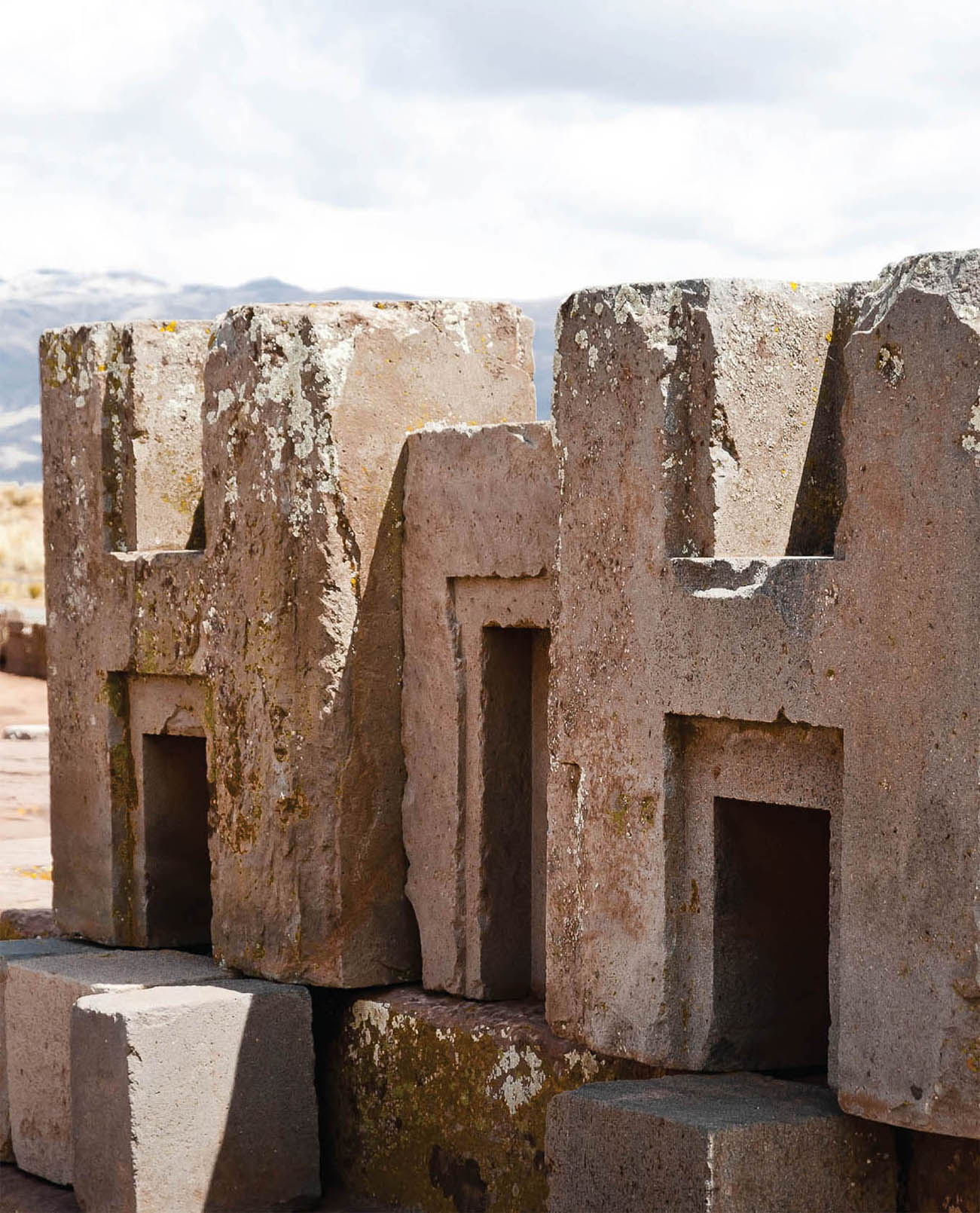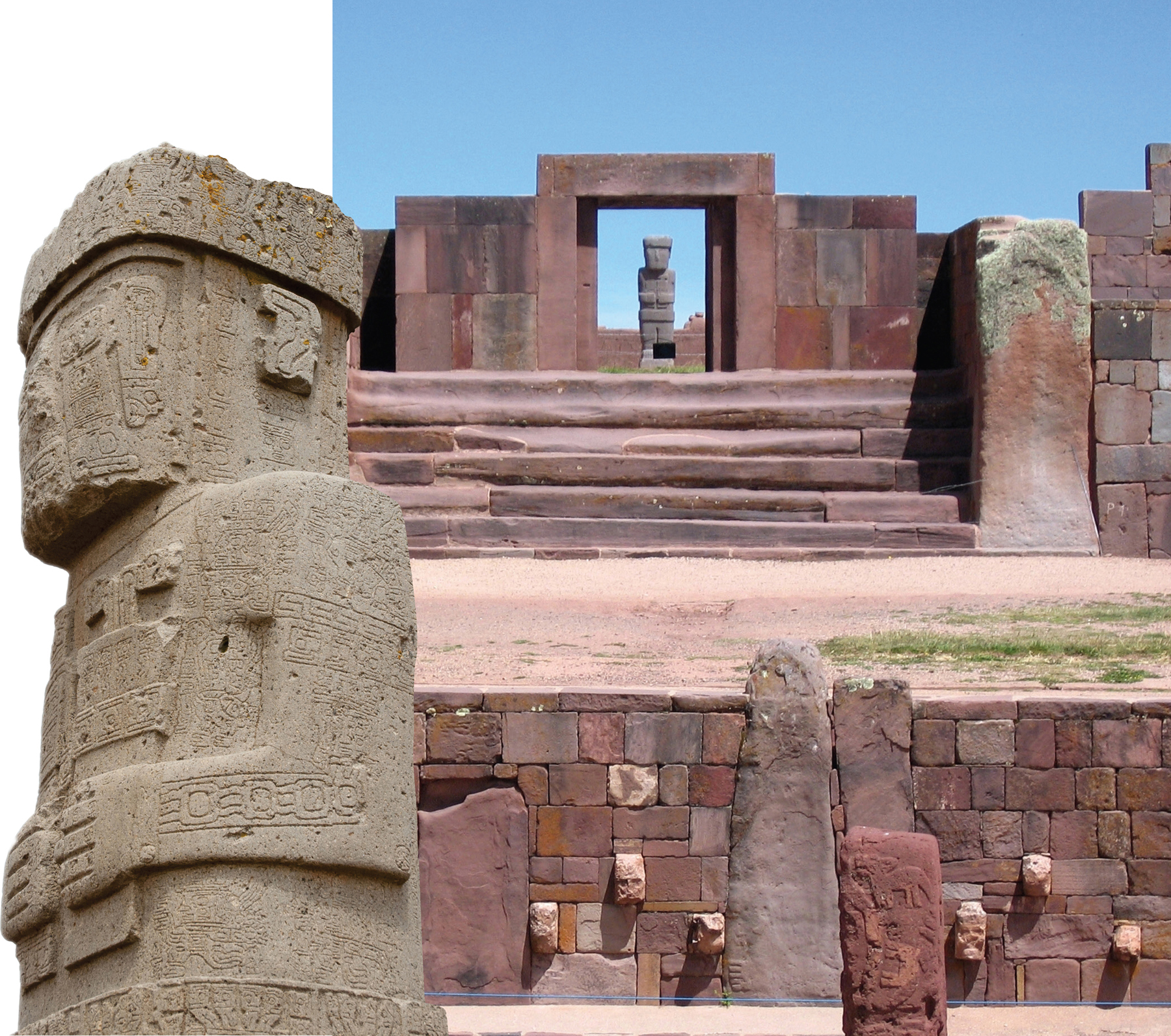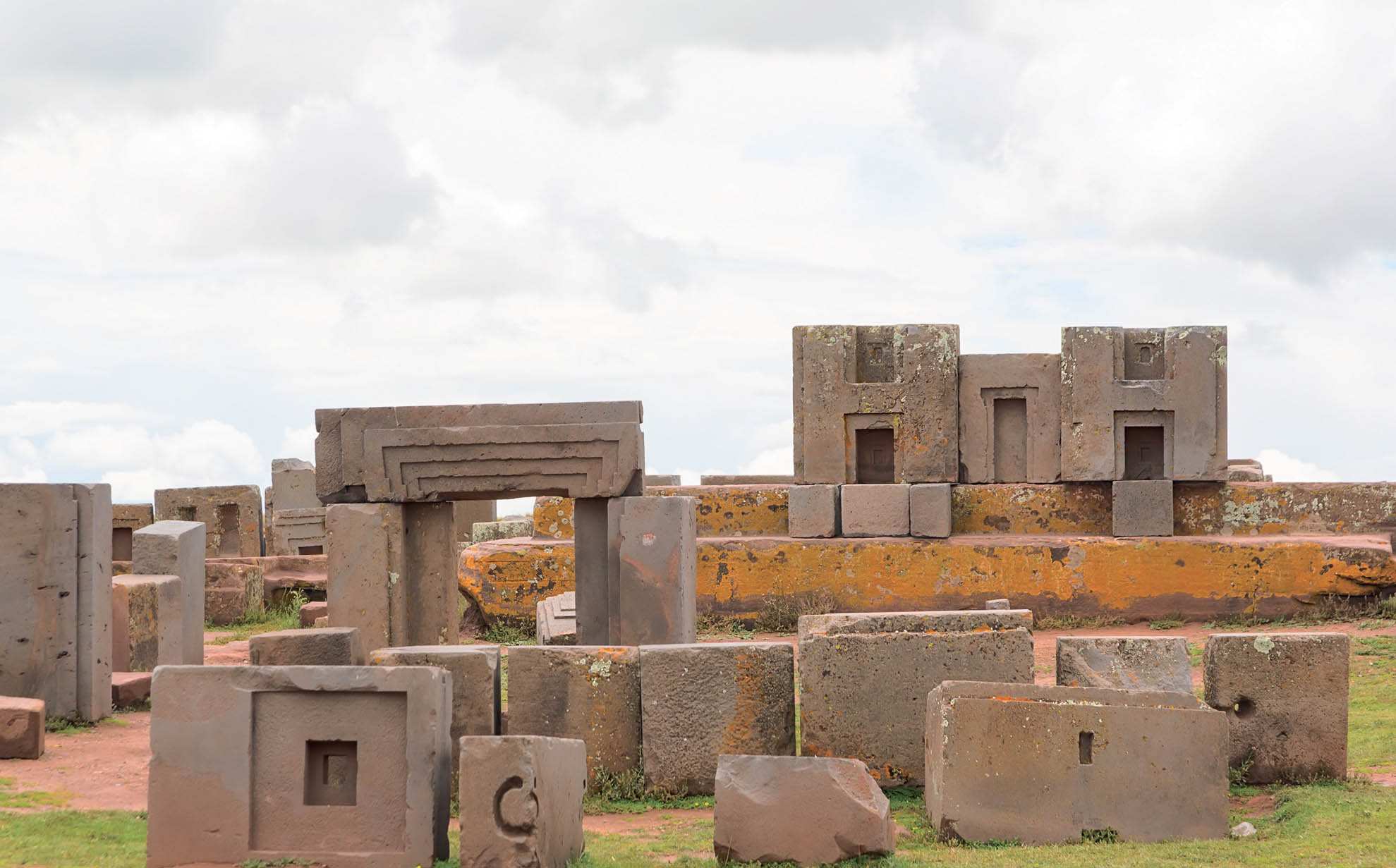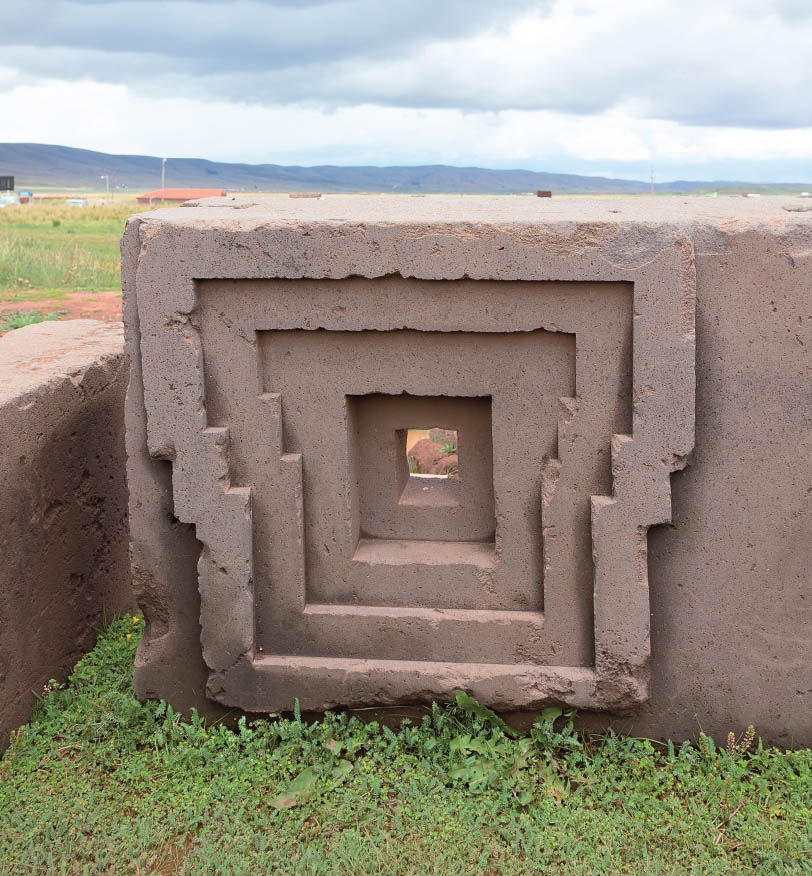
Photon-Photos / iStock / Getty Images
The most tangible evidence that we have regarding possible extraterrestrial technology is, in my opinion, the stone-cutting techniques of some ancient civilizations. Because in some instances, we ourselves today would have great difficulty replicating what our ancestors allegedly accomplished with stonemasonry. Puma Punku is such a prime example.
In 1549, while searching for the capital of the Inca Empire, Pedro Cieza de León and his Spanish conquistadors discovered the ruins of what looked like a massive temple complex at what is now called Tiahuanaco (also known as Tiwanaku). Mainstream archaeologists suggest these ruins were once the center of the Tiahuanaco civilization, but little is known about the forty thousand or so people who lived here or the structures they left behind.
Of special interest are the walls of Tiahuanaco’s large courtyard, which feature numerous carved stone faces that may suggest those of extraterrestrial visitors. But located just a half mile away from the temple at Tiahuanaco lie the ruins of what is thought to be yet another temple complex, the mysterious site known as Puma Punku, “The Gateway of the Puma.” The name was given by the local Aymara people, who found artifacts at the site depicting warriors wearing masks made of puma skulls. But what was it? A temple? A meeting place? Some elaborate monument? All of these possibilities have been suggested, but to this day no one knows just what this place was, who built it, or exactly how old it really is.

The Ponce Stela (left), a monolithic statue in the Temple of Kalasasaya at Tiahuanaco. The Ponce Stela is visible through the main door of Kalasasaya as seen from the subterranean temple. The walls of the subterranean temple are covered with 194 carvings of faces, each one different from the next.
javarman / Shutterstock.com
Paulo Afonso / Shutterstock.com

Massive stone “H” blocks at Puma Punku. Each stone was cut with incredible precision, designed to interlock with the surrounding stones. The blocks fit together like a puzzle, forming load-bearing joints without the use of mortar.
Dmitry Burlakov / Shutterstock.com
Puma Punku is located in the highlands of the Bolivian Andes. It is situated next to Lake Titicaca, the highest navigable lake in the world. The ruins we find at Puma Punku are simply extraordinary. Puma Punku defies logic and has no comparison anywhere in the world. What we have there are not only gigantic stone platforms, which at one point in time possibly all fit together, but we also have stone cuts that are highly sophisticated and that have nothing to do with anything ritualistic or with any ornamentation such as the depictions of flowers, faces, or animals, or something that has been created for the worship of the gods. Puma Punku is an anonymous site. There are no inscriptions there. No depictions of any people. In my opinion, Puma Punku is the most mysterious site on Planet Earth, eclipsing even the pyramids at Giza.
The most prominent stones featured at Puma Punku are grey andesite and red sandstone. We find clear evidence of a machining signature at Puma Punku. How this was done remains a mystery to this day. We also find what seem to be physical impossibilities in ancient rock-cutting techniques—in Ollantaytambu, Peru, for example—where entire blocks of stone were somehow cut out of the rock face. How was the back of that block released so that the block could be taken out from the rock face? It seems that what we have here is a physical impossibility. I’ve talked to mining engineers and all sorts of people involved with rock cutting, and they told me that unless you have an access point where you can slide the blade behind it, you cannot do this. If modern-day engineers tell me that today we don’t have an easy way of doing this, then how on Earth did our ancestors succeed in releasing the back of the block?

Megalithic Andesite blocks at Puma Punku. On the right side of the image is a block featuring four equidistant holes carved into its corners.
Adwo / Shutterstock.com

Precision stonework at Puma Punku.
Adwo / Shutterstock.com

Extraordinary craftsmanship at Puma Punku.
Dmitry Burlakov / Shutterstock.com
The reason I am convinced that sophisticated technology was utilized in cutting these ancient rocks is that if we go to a stone quarry today and look at the scope of machinery required to accomplish similar things, well, those machines are huge. They’re monstrosities that not only have these big, gigantic blades to release the stone blocks from the rock face, but also need added water, because if you don’t add water to the blades, then the blades will get too hot and disintegrate or melt.
At Puma Punku there’s this one andesite block that has this perfect groove with holes drilled at equidistant positions. Now, it is a scientific fact that an andesite block cannot be cut with copper tools. That’s just how it is. For many years, researchers have suggested that some type of laser or plasma tools were used at Puma Punku. However, through machinist and toolmaker Christopher Dunn’s research, we have evidence that lasers or plasma tools—heat-related tools—were never used on these blocks. However, what we do find is a surface that might have been achieved with a type of diamond saw or diamond mill. Anyone who has ever been to Puma Punku marvels at the fact that when you touch the cut rocks, their surface is extremely fine. It’s almost like touching a bathroom mirror—that is how fine and perfect the surfaces are at Puma Punku. The mainstream archaeology explanation that all of this was accomplished with obsidian or with chicken bones doesn’t hold up.
Another question we have to ask ourselves is, How were these giant platforms moved from point A to point B? According to some scholars, the quarries for these stones were as far away as eighty miles. Some have suggested that these stone blocks were transported with the help of wooden rollers. But what nobody talks about is the fact that Tiahuanaco is situated at an altitude of 12,800 feet, which means we are above the natural tree line. No trees ever grew in that area, meaning no trees were cut down there to use as wooden rollers. The wooden-roller theory falls away.
On Wikipedia you can read that Puma Punku was built between AD 536 and AD 600. But, if you ask somebody like me, Puma Punku and Tiahuanaco might date back as far as 12,000 BC —about 14,000 years ago. And the idea that a precivilization existed before our recorded history is something that ancient astronaut theorists have tried to prove for a very long time—that our history dates back much further than what we have been taught.
![]()
Puma Punku and Tiahuanaco might date back as far as 12,000 BC
![]()
When Dr. Arthur Posnansky, an eminent archaeologist, looked at Tiahuanaco, he determined the symbols that are carved on many of the monuments are part of a calendar. When he sat down to calculate the age of the monuments based on that calendar, he came up with a number that is incredibly old, at least ten thousand years. One of the results that he calculated actually went back seventeen thousand years. So we have a monument that for all intents and purposes was determined, through its own calendar, to be seventeen thousand years old. Mainstream archaeologists consider those calculations false. They think that he might have made a mistake or that the symbols themselves contained mistakes essentially indicating that our ancestors didn’t know what they carved into the rock. I disagree with that notion, because our ancestors were as smart as we are today, intellectually speaking. The only variation is that they had a difference in comprehension of technology. In other words, their technological frame of reference was more primitive than ours today.
Today, with ground-penetrating radar, researchers have actually determined that there are more blocks, and some of these blocks are now being excavated at a depth of twelve feet. This means there is a lot of soil that had to have been built up for everything to disappear. The idea is that the reason we can find blocks and structures that are five, six, and ten feet underground is that at some point some type of a cataclysm happened that washed over everything and thus we have that thick soil level above those structures.
GOLD FLYERS
![]()
The dense jungles and rugged mountains of Colombia contain a vast number of archaeological sites. Many treasure hunters believe the legendary city of gold, El Dorado, lies hidden there, somewhere beneath a thick canopy of trees. While the mythical metropolis has yet to be discovered, early in the twentieth century tomb raiders searching along the Magdalena River stumbled upon a grave site that mainstream archaeologists date back to a pre-Columbian civilization known as the Quimbaya (Tolima). The Quimbaya were famous for their gold and metalwork.
Among the objects the tomb raiders found were thousands of small, two-to three-inch solid gold figurines, intricately and precisely carved. Though many of the figurines represented local insects and wildlife, a handful stood out for their remarkable resemblance, in minute detail, to modern aircraft—demonstrating that the Quimbaya understood the principles of flight. In 1996, German aviation enthusiasts and model builders Dr. Algund Eenboom and Peter Belting successfully built and flew remote-controlled scale models of two of the gold flyers, adding only landing gear and an engine—demonstrating without a doubt that the gold Quimbaya flyers are aerodynamically sound.

Erich von Däniken / Courtesy Erich von Däniken Archive
How could our ancestors—who lived thousands of years before aerospace engineering—have so accurately depicted airplanes? Could they have observed such craft firsthand? Is it possible that our ancestors witnessed aircraft in flight, similar to our modern planes, piloted by extraterrestrial beings?
So who built Puma Punku? According to the native Aymara people, it was not them. When you ask them who built it, they point to the sky and say it was los dioses: the gods. So then we have what is called living mythology, in which people still alive today tell us exactly how some of these things came about. The Aymara themselves say that they had no hand in building Puma Punku. According to oral traditions of the Aymara, Tiahuanaco was built as a place of pilgrimage for significant events that took place at Puma Punku. What were these significant events? According to the traditions, people descended from the sky and jump-started civilization in that region of the world. Yet when we hear stories like this, we look the other way and say, Oh, come on. It’s nothing else but fantasy.
When the first Spanish chroniclers appeared on the scene, and they asked the locals “Who built Puma Punku?,” the locals told of a legend that Puma Punku was built in a single night by the gods. When you look at the complex that we find today, though, it’s very hard to believe that any of this was built in one night. Again, what we have here is mythology. But any type of mythology is rooted in some type of truth. So we have to figure out what the truth is behind Puma Punku.
![]()
The locals told of a legend that Puma Punku was built in a single night by the gods.
![]()
Calendar calculations of some of the glyphs found at Tiahuanaco suggest that Tiahuanaco may have been built because of what may have happened at Puma Punku before. And Tiahuanaco is nothing else but a place of pilgrimage for people to congregate and remember the time when something significant happened at Puma Punku. In my opinion, the thing that was significant about it was an extraterrestrial visit by ancient aliens in the remote past that our ancestors witnessed firsthand.
I think that Puma Punku is the only site on Planet Earth that may have been built directly by extraterrestrials. Even though I wouldn’t be surprised if the extraterrestrials commissioned the Aymara to help them in their undertaking. I say this because I don’t think the extraterrestrials ever got their hands dirty. They simply showed our ancestors how to use their machines. To be clear, the pyramids were built by human beings. In fact, I think that all of the ancient monuments were built by human beings. But the extraterrestrials shared their engineering knowledge with our ancestors. Puma Punku was a type of base camp from which they sent out their craft in order to explore, for example, the Americas. Bear in mind that we also have stories of Viracocha or Kukulcan or Quetzalcoatl—the winged serpent—arriving at Lake Titicaca, which is considered to be a navel of the world. And a navel of the world in ancient times was considered to be a place where life originated. Delphi, Greece, is considered another such navel.
Today, Puma Punku is in ruins. That means there was a point in time when Puma Punku was complete. So what happened? Is it possible that some type of a cataclysmic event destroyed Puma Punku? Or was it disassembled on purpose? As with any visit, or any project, the time arrives when it is finished. And that is why some of these contacts ended—because the extraterrestrials went on to different places. I also speculate that Puma Punku was deliberately destroyed by its original builders, the extraterrestrials, right before they decided to leave Planet Earth and go on to their next mission.
